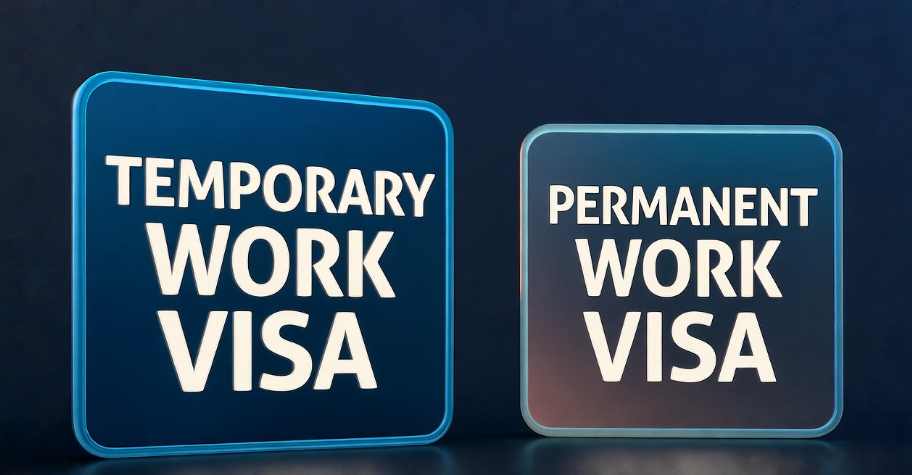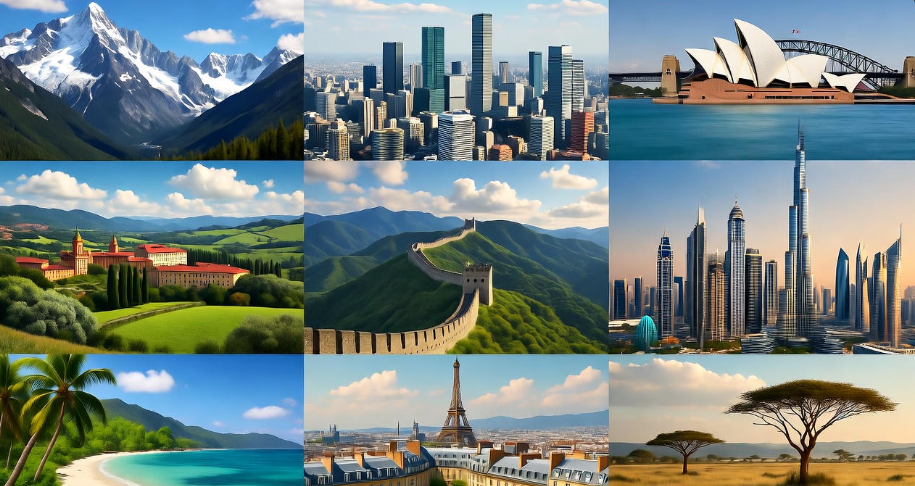If you’re dreaming about working abroad — maybe in Canada, the USA, the UK, Australia, or anywhere else — one of the first things you’ll hear about is a work visa. But here’s where many people get confused: there are two major types — temporary work visas and permanent work visas.
Both let you work legally in another country, but they’re very different when it comes to duration, benefits, rights, and future options. Let’s break it all down in simple terms — no legal jargon, just clear and honest talk.
What a Work Visa Actually Means ✈️
A work visa is an official document or stamp that lets you legally work in a foreign country. It’s like a work permit, but often tied to your residency status. Some people call it a “work authorization,” but they all point to the same thing — permission from the government to earn money while living there.
When applying for one, you usually need:
-
A job offer from an approved employer
-
Proof of your skills or qualifications
-
Health and background checks
-
And sometimes, language tests or financial proof
Once you’ve got all that, you can enter and start working. But the type of visa you get determines how long you can stay, whether you can switch jobs, and if you can later settle permanently.
Temporary Work Visa – The Short Stay Option
Let’s start with the temporary work visa, often called a non-immigrant work visa. It’s meant for people who want to work abroad for a specific time — usually a few months or a few years — but not permanently.
You might get one if you:
-
Have a short-term contract
-
Are going on a project-based assignment
-
Or just want to gain international experience before returning home
Some common examples include:
| Country | Temporary Work Visa Type | Duration | Renewable |
|---|---|---|---|
| USA | H-1B (Specialty Occupation) | 3 years | Yes (up to 6 years) |
| UK | Skilled Worker (Temporary) | 2-5 years | Renewable |
| Canada | Temporary Foreign Worker Program | 1-2 years | Renewable |
| Australia | Temporary Skill Shortage (TSS) Visa | 2-4 years | Renewable |
Main Features of a Temporary Work Visa
-
Fixed Duration – Most last between 6 months to 5 years. After that, you either renew it or leave the country.
-
Employer Tied – Usually, you can only work for the company that sponsored your visa. Switching jobs often means applying again.
-
Limited Benefits – You get permission to work, but not full rights like permanent residents (no voting, limited healthcare, etc.).
-
Family Restrictions – Your spouse or kids may not automatically get work rights unless you apply for their dependent visa.
-
No Direct PR Path – Some temporary visas allow you to apply for permanent residency later, but not all.
Why People Choose Temporary Work Visas
There are actually lots of smart reasons why someone would go for a temporary visa first:
-
It’s faster to get approved than permanent visas.
-
You can test the country before deciding to settle there.
-
It helps you gain foreign work experience and improve your CV.
-
Some companies offer sponsorship extensions or help you later apply for PR.
But there’s one catch — you’re not guaranteed to stay forever. When the job ends or your visa expires, you usually need to go home unless you’ve applied for another visa or permanent residency.
Permanent Work Visa – The Long-Term Dream
Now let’s talk about the permanent work visa — the one that lets you stay for good. This is the golden ticket for anyone looking to live, work, and eventually become a citizen in another country.
It’s often called a residency visa or employment-based green card, depending on the country.
This visa is for those who plan to build a life abroad — not just a short work experience.
| Country | Permanent Work Visa Name | Path to Citizenship |
|---|---|---|
| USA | Employment-Based Green Card (EB-1, EB-2, EB-3) | After 5 years |
| Canada | Express Entry (Federal Skilled Worker) | After 3 years of residency |
| Australia | Employer Nomination Scheme (Subclass 186) | After 4 years |
| UK | Indefinite Leave to Remain (after 5 years of work) | After 6 years |
Main Features of a Permanent Work Visa
-
No Expiry – You can live and work indefinitely.
-
Freedom to Change Jobs – You’re not tied to one employer.
-
Full Rights – You get access to healthcare, social services, and sometimes even education benefits.
-
Path to Citizenship – You can apply for citizenship after living there for a few years.
-
Family Benefits – Your spouse and children can live and work too.
Why Permanent Work Visas Are Harder to Get
Permanent visas are great, but they’re not easy to secure. Governments have strict quotas, and you usually need:
-
Strong qualifications or skills in demand
-
A stable job offer or high points score (in point-based systems like Canada)
-
Clean background and good health
-
Proof of financial stability
It can take months or even years to process, but once approved, it’s worth it. You get stability, benefits, and a real chance to build a future.
Temporary vs Permanent Work Visa – Key Differences ⚖️
| Feature | Temporary Work Visa | Permanent Work Visa |
|---|---|---|
| Duration | Limited (months or years) | Indefinite |
| Job Flexibility | Restricted to one employer | Freedom to switch jobs |
| Benefits | Limited rights | Full rights and privileges |
| Family Sponsorship | Limited | Full sponsorship allowed |
| Path to Citizenship | Not always available | Yes, available |
| Processing Time | Faster | Longer |
| Cost | Generally lower | Higher application fees |
| Renewal | Needs extension | Not required |
So, in short: a temporary visa is for working abroad, while a permanent visa is for living abroad.
Which One Is Right for You?
This depends on what stage you’re at in life.
-
If you’re young, exploring, or testing the waters, a temporary visa makes sense. You can get international exposure without committing forever.
-
But if you’re settled in your career and want long-term security for your family, a permanent visa is the smarter choice.
Many people actually start temporary and move to permanent later. For example, someone on a Canada Work Permit might apply for Express Entry after gaining local experience.
So it’s not always one or the other — sometimes, it’s a journey from temporary to permanent.
Related post: Easiest Countries to Get a Work Visa in 2025
Common Myths About Work Visas
-
“You can’t switch from temporary to permanent.”
False. Many countries allow transition pathways — you just need to meet the requirements. -
“Permanent visas are only for rich people.”
Nope. Skilled professionals, nurses, engineers, and even tradespeople qualify if their skills are in demand. -
“Temporary visas can’t be renewed.”
Some can, often multiple times. It depends on your country’s rules and employer’s support. -
“Once I get a work visa, I can work anywhere.”
Not always true. Most temporary visas are employer-specific. You’ll need permission to change jobs.
Important Tips Before Applying for Any Work Visa
-
Always research visa types before applying — every country has different categories.
-
Keep your documents ready: job offer, qualifications, passport, and medical records.
-
Don’t fall for fake “visa agents.” Always apply through official government websites.
-
Make sure your employer is authorized to hire international workers.
-
Learn basic local laws and work rights — this helps you avoid exploitation.
Pros and Cons Overview
| Category | Temporary Visa | Permanent Visa |
|---|---|---|
| Pros | Easier to apply, quick approval, less documentation | Long-term stability, full rights, family benefits |
| Cons | Short duration, job restrictions, limited benefits | Long process, strict eligibility, higher cost |
| Best For | Short-term work, training, internships | Long-term settlement, family migration |
A Real-World Example
Let’s say you’re a software engineer from Pakistan who got a 2-year job in the UK under the Skilled Worker Visa. That’s a temporary work visa. You go, work hard, gain experience, and your company decides to keep you longer.
After 5 years, you apply for Indefinite Leave to Remain (ILR) — that’s your permanent visa. Once approved, you can stay forever, work anywhere, and even apply for citizenship later.
That’s how most people move from temporary to permanent. It’s a process, not a one-time event.

Quick Comparison Table
| Factor | Temporary Work Visa | Permanent Work Visa |
|---|---|---|
| Stay Duration | 6 months – 5 years | Indefinite |
| Renewal | Required | Not required |
| Dependents | Limited rights | Full rights |
| Work Freedom | Restricted | Open |
| PR Eligibility | Sometimes | Always |
| Citizenship Option | No | Yes |
| Health Benefits | Basic only | Full coverage |
| Application Difficulty | Easy | Complex |
The Bottom Line
If you think about it, temporary visas open doors, but permanent visas build homes. One gives you a taste of working abroad, and the other gives you a future there.
Both have value — it all depends on your goals. Some people just want experience and return home richer in skills. Others want to start a new life abroad with family and stability.
So before applying, ask yourself:
Do I want to work abroad for a few years?
Or do I want to live there permanently?
Once you know the answer, your visa path becomes clear.
FAQs About Temporary vs Permanent Work Visas
Q1: Can I change my temporary visa into a permanent one later?
Yes, in many countries like Canada, Australia, and the UK, you can apply for permanent residency after working for a few years on a temporary visa.
Q2: Do both visa types allow me to bring my family?
Yes, but with conditions. Permanent visas usually allow full family rights, while temporary ones may have restrictions.
Q3: Which visa is easier to get approved?
Temporary visas are usually faster and less complex. Permanent visas need more documentation and points.
Q4: Can I lose my permanent visa?
If you break immigration laws, commit crimes, or stay outside the country for too long, yes, it can be revoked.
Q5: Do I need a job offer for both visa types?
Mostly yes — especially for temporary visas. Some permanent visas, like Canada’s Express Entry, may allow you to apply without a job offer if you have enough points.
Q6: Which visa helps me get citizenship faster?
Permanent work visas always lead to citizenship faster since you’re already counted as a long-term resident.
Final Thoughts
At the end of the day, a temporary work visa is like testing the waters, while a permanent work visa is like diving in to build a new life.
If you play your cards right, the temporary one can be your stepping stone toward the permanent dream. Just stay informed, follow legal routes, and never rush the process — good things take time.
Working abroad can change your life — new opportunities, cultures, and horizons. Whether short-term or long-term, every experience counts. ✨




